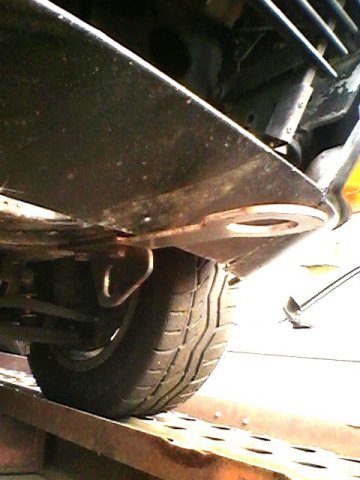-
Posts
629 -
Joined
-
Last visited
-
Days Won
2
Content Type
Profiles
Forums
Blogs
Events
Gallery
Downloads
Store
Everything posted by beermanpete
-
http://forums.hybridz.org/topic/98733-itemized-list-of-weights-for-the-purpose-of-weight-reduction/?hl=%2Bweight+%2Bparts
-

Lug Nut Help, Acorn or Mag??
beermanpete replied to AkiraZX's topic in Brakes, Wheels, Suspension and Chassis
You can add the steel insert if you feel the need. http://www.prestigewheel.com/Imagewi510.asp#Cone%20Seat%20Inserts -

Lug Nut Help, Acorn or Mag??
beermanpete replied to AkiraZX's topic in Brakes, Wheels, Suspension and Chassis
Based on the size of the chamfer I suspect you should use the acorn style lug nuts. The mag style has a small footprint washer and it will not support much load with the heavy chamfer. -

How do I interpret the amp meter
beermanpete replied to RebekahsZ's topic in S30 Series - 240z, 260z, 280z
Correct. Most cars turn off accessories during cranking to maximize power availability for cranking and a hot spark. The voltage without a load on the solenoid wire does not matter. You need to measure the voltage with the solenoid connected. The best time to do this is when the problem occurs (the car is not cranking). Intermittent problems can be tough to find. Try disabling the ignition coil so you can crank longer without the engine starting. You might need a helper to turn the key while you take measurements. More than about 1/2 volt drop is too much and indicates one or more loose/dirty connections in the circuit. -

How do I interpret the amp meter
beermanpete replied to RebekahsZ's topic in S30 Series - 240z, 260z, 280z
You might be hearing the accessory relay opening because the accessory circuit is shut off while the ignition is in the start position. -
The fuel is not supposed to come ouf from that tube. The floats are likely sticking open and allowing the flaot bowls to overfill and flood. You should rebuild the carbs, or at least take the float bowls off and clean them out. Make sure to clean the float valves (needle and seat) as well.
-
The caliper will find its own center due to the floating desing. What needs to be on center with the rotor is the mounting bracket. If the rotor is dragging on both pads the pads are too thick or the rotor is too thick (assuming the caliper piston is fully depressed and not held out due to corrosion or debris in the bore.)
-

heavy steering effort in '72 240Z
beermanpete replied to vtdds71's topic in S30 Series - 240z, 260z, 280z
My car is similar to your description. It seems to be the nature of the Z. To create castor adjustment you need to replace the tension rods with aftermarket parts that include a length adjustment: https://technotoytuning.com/nissan/240z/tension-control-rods-datsun-240z-260z-280z -

Has anybody gotten all you can get out of a stock cam?
beermanpete replied to HowlerMonkey's topic in Nissan L6 Forum
Talk to people who race, or have raced, in classes requiring stock cams. They are likley the people who have work the hardest to get power from a relatively stock engine. -

Odd brake rotor wear pattern
beermanpete replied to RebekahsZ's topic in Brakes, Wheels, Suspension and Chassis
Perhaps some sort of resonance? Is there any noise while braking? Very odd pattern. I have never seen that before. -
So, much like the IRS the CA DMV assumes you are guilty until proven innocent. That sucks. I have no idea how you should proceed with the DMV. As for the bank charges, if you use a "real" credit card you can dispute the charges more easily than if you use a debit card. Not much now of course, but for the next time it might help.
-

How do I interpret the amp meter
beermanpete replied to RebekahsZ's topic in S30 Series - 240z, 260z, 280z
Unless you have high-wattage headlamps your alternator is weak or the belt is slipping (worn, loose, oily, etc.) Either way some work on the chargin system seems to be in order. -

How do I interpret the amp meter
beermanpete replied to RebekahsZ's topic in S30 Series - 240z, 260z, 280z
The ammeter shows the battery charge/discharge rate. All current into and out of the battery (except for the starter motor) flows through the ammeter. When the car is not running and you turn on the lights or other load you will see the ammeter swing to the discharge side (left). When you start the engine and the alternator starts charging you will see it swing to the charge side (right) and then taper down to zero after a short time (a minute or two). When you are driving the meter will sit on zero most of the time. When the engine is at idle (stopped at a traffic light) the alternator does not have as much output and might not "keep up" with the load (worst case: headlights on, heater on, wipers on, in the rain at night). This will cause the battery to become the current source (discharge) and the ammeter will swing to the left. When you pull away for the light and the alternator output increases the meter will swing to the right momentarily while the battery is recharging. The meter will then taper back to zero again as you drive. If the ammeter is ALWAYS to the left or the right of zero a problem is indicated. Always to the left suggests a weak or failed alternator or regulator. Always to the right suggests a failed regulator that is over-charging. In your case, it is possible the car is fine but you are not running the engine enough between start-ups to fully recharge the battery. Do you have the same problem driving on the street (assuming you do)? -

Clutch will not disengage: Tried everything
beermanpete replied to Ben's Z's topic in Trouble Shooting / General Engine
Right.So why did you replace the master if it was still good? The spring I mentioned is not a return spring, it is inside the slave and pushes the piston out toward the release arm to keep a little pressure on the rod to prevent it from falling out when the clutch is engaged. You need to separate the diagnostics to the various systems involved. First: Verify the clutch pedal and push rod are in good condition and adjusted correctly. Read the manual for details. Second: Verify the hydraulic system working. Does the slave move in response to actuating the master? Does the slave stay extended if you hold the pedal down, or does it slowly return on its own? Third: Verify the slave and release arm are in the correct position. Where is the piston when the clutch released (pedal down)? Is it half out of cylinder bore? Where is the piston when the clutch is engaged (pedal up)? Is it fully bottomed in the bore and there is still pressure on the push rod and release arm (can you move the arm by hand?) It still sounds to me like you have a short collar for the throw-out bearing. Having a short collar will result in a very soft pedal and no clutch release, which is what you have described. -

Converting my car from 4 to 5 speeds?
beermanpete replied to yamahondarider's topic in S30 Series - 240z, 260z, 280z
The clutch and drive shaft are the same as long as the 5-speed is not a T5 from a Turbo. That caveat aside it is a straight bolt-in swap. -
We scrapped the rusted out 260Z body yesterday.
-

FS5W71B - Item that might be overlooked on rebuild often?
beermanpete replied to inline6's topic in Drivetrain
Duragg makes a good point. Check the trans vent at the top of the tailshaft. If it is blocked the heat expansion of the air will casue oil leaks. Also, check the bore for the oil seal, perhaps if has a gouge in it from changing the seal that is causing the leak. -

Clutch will not disengage: Tried everything
beermanpete replied to Ben's Z's topic in Trouble Shooting / General Engine
When you say it goes (went) into gear with the wheels in the air but not on the ground does that mean the rear wheels are stationary with the transmission in gear, engine running, and the clutch pedal on the floor? It sounds like you need a longer push rod for the clutch master. The pedal needs to be all the way up when released to get the full pedal stoke. There should be a little free play in the pedal before the push rod starts moving the master. Read the FACTORY service manual. It has the adjustment procedure, correct pedal height, and free play specification. If you cannot get the pedal set per this procedure you have the wrong push rod. There should not be any free play at the slave. The pressure plate pushes it back until the clutch is fully engaged. At this point the piston and seal in the master should have opened the vent hole to the reservoir and all presusre is released from the slave. A light spring and friction hold the slave piston in place and keeps the rod engaged into the piston and release fork sockets. If it gets loose it could fall out of place. If the slave piston extends out of the cylinder bore when you push the clutch (pull back the boot and look) you have a short throw out bearing collar. -
The tow hooks for the 240Z and 280Z are different. We learned that the hard way. Somehow we ended up with the 280Z type and it won't fit the 240Z so I made my own. The difference seems to be related to the changes for safety bumper fitment. Since the 260Z had both you should look at the bumper mounts to very which type your car has. A call to the supplier is a good idea as well.

